A cooperative board game `` Yggdrasil Chronicle '' that protects the three-layer world supported by a huge world tree as Nordic gods

Became the gods of Norse mythology, the full Japanese version of the board game ' Yggdrasil Chronicle ', which protects the huge Yggdrasil tree that supports the world from giant monsters, appeared in December 2019. A beautiful component that reproduces the world view of Nordic mythology such as a huge three-dimensional board that reproduces the tree of Yggdrasil is attractive, it is not a battle-type board game where players compete with each other, but a cooperative board game where the game system and the player fight. So I actually played around with it.
Yggdrasil Chronicle | | ANALOG GAME INDEX
◆ Contents
The package of the Yggdrasil Chronicle, in which a gigantic world tree is drawn, looks like this. As you can see from the image below held by a female editorial staff, it is a fairly large size for a board game.
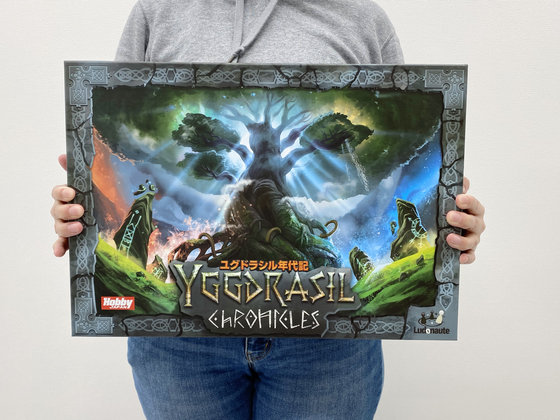
The playing time is 90 minutes, and the number of players is 1 to 5.

Open immediately.
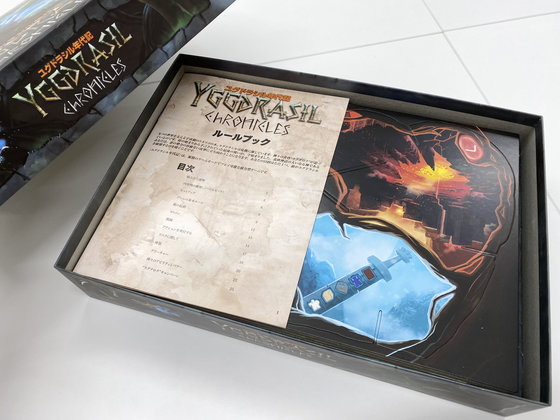
Inside is a rule book and seven pieces of cardboard that are parts of the playing board.

The cardboard already has cuts in it, so you can easily remove it without using scissors or a cutter.

And the saga book, the parameter sheet of the character used in the additional campaign, and 7 god sheets. The name and illustrations of the gods of Norse mythology are drawn on the god sheet.

5 wooden pieces and 2 dice

Flame Giant Koma, Nameless Koma, Yotun Koma, Hero Koma, and Elf Koma are all like this.

Unlike ordinary dice, the Van Divine Dice and God Dice have symbols rather than numbers.

7 god figures and 11 enemy figures

18 Sacred Cards, 18 Yotun Cards, 18 Creature Cards, 42 Enemy Cards.

◆ Assembly of Yggdrasil
First, I will remove the parts from the cardboard and assemble the world tree 'Yggdrasil' which will be the stage of the game. How to assemble is written in the rule book, but since it is only an illustration, it is not written which parts to bring from which thick paper, so I had a hard time.

3 pieces that make up the trunk of Yggdrasil

When combined, it looks like this.

Stick the assembled three layers on the trunk.

Insert the branches that support the upper layers ...

Completion of Yggdrasil.

Yggdrasil is divided into 3 levels, and each layer is divided into 3 worlds. The upper layers are Vanaheim (the world of Van gods), Asgard (the world of gods), Alfheim (the world of elves), and the back of Asgard traps rebel bandits against the gods. cage Exists

There are three middle layers: Swart Alfheim (Night Creature World), Midgard (Human World), and Nizavellil (Dwarf World).

The lower layer is made up of three parts: Nivrheim (World of the Dead), Yotunheim (World of Yotun), and Muspelheim (World of Fire).

Next, we will install enemies against God. First, place Loki in Vanaheim. Loki who draws blood of Yotun, the enemy of the gods, Kin However, in Ragnarok (the last day) that occurs at the end of Scandinavian mythology, he is one of the enemies trying to destroy the Earth god.

Loki's child, a giant wolf Fenrir . Fenrir is locked up in a cage because, in mythology, 'it was under the supervision of the Earth priest and was detained.'

Jormungand , a child of Loki and a monster of a viper, winds up in Midgard.

Giant Sult, who burns up the world, is placed in Muspelheim.

The goddess of death, Hell , is the sister of Jormungand to Nivleheim.

Place the needs hegg on the icon of the saga book. Needs Heg is a dragon that bites the roots of Yggdrasil, the world tree, and is said to survive Ragnarok. If you move this Needs Heg to the far right icon, the player wins.
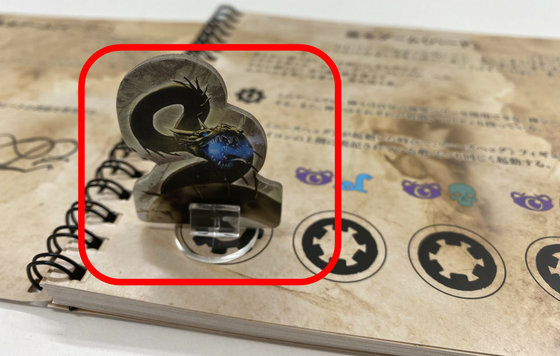
◆ Play with 5 people
This time, 5 players, Thor, Tulle, Odin, Freya, and Heimdal played the basic game (hard mode).

God sheet distributed to each player. Place 5 life point tokens and the enemy card on the back of your god.

Then give out one dice to the players.

After starting the game, everyone puts all the enemy cards face down on the enemy wheel in the center and decides the order of the 5 players. The play order of this player is not fixed until the end of the game, but depending on the round it may be changed depending on the situation.

First, when Freya flipped over the card, it was Surt's card. Place a card in the hollow with the name of Surt on the enemy wheel.

After flipping through the cards, perform the 'Move on Yggdrasil' phase and the 'Fulfill mission' phase in sequence. You can only move vertically or horizontally on Yggdrasil. Therefore, the point of this game is that there are places that cannot be moved in one turn depending on the position. Also, you don't have to move.

After the 'Move over Yggdrasil' phase, move to the 'Fulfill Mission' phase. In this phase, you can either activate the unique action of the world you are staying in or fight an enemy in the same world. For example, the god Odin in Nizavellil can draw a sacred card on the board.

The card I drew is Flinghorni, a ship owned by Baldol, the God of Light. The effect is that you can move anywhere in the lower world, ignoring the movement rules in the 'Move on Yggdrasil' phase. Since the sacred card has a permanent effect, it is a powerful card that can be used any number of times until the end of the game.

You can also get the Van Divine Dice at Vanaheim. The Van Divine Dice is very important because it can be rolled along with the Divine Dice during battle, increasing the chance of being in an advantageous situation.
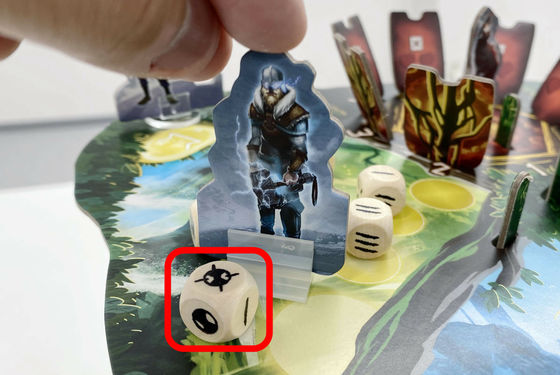
After all 5 turns, 'Flip cards →' Move on Yggdrasil 'phase →' Fulfill your mission 'phase', move on to the next round, and all players will issue cards and decide the order of play, and turn The flow is to proceed.
In the next round, Loki appears when Freya flips through the cards. This is the second one because Loki was already in the scene. When two identical enemy cards are displayed on the field, the enemy will start and start acting. In addition, the action pattern of the enemy when activated depends on the enemy.
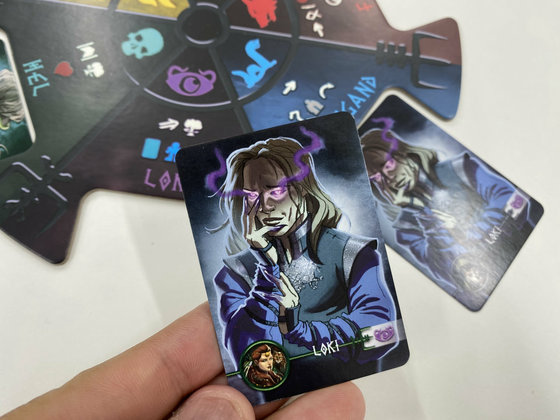
When Loki starts, first Loki moves to the activated god, in this case Freya.

Then rotate the mid-tier board 120 degrees clockwise. This shifts the middle-level world by one, changing the route in the 'Move on Yggdrasil' phase.
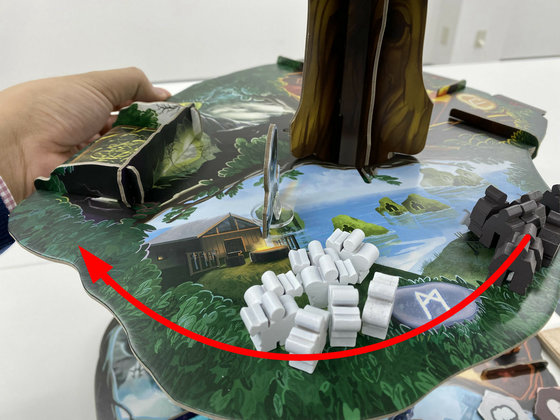
Then draw a Yotun card from the lower Jotunheim. The one I drew this time is Hurokin, a female giant. On the lower right of the Hurokin card is the Hell mark.

Take one Yotun in the corner of Yotunheim ...

Attach to Hell's figure. Yotun is an obstacle to the movement of the gods. In this case, Yotun replaces Hell, so he cannot be defeated immediately.

The place where Yothun is placed is like a meter. This meter shows Loki's attack power. In other words, the attack power increases by one each time Loki starts.

In the next round, Freya chose to fight Loki in the same world in the 'Fulfill Phase'.
Since God is overwhelmingly strong, the battle between God and the enemy automatically wins, but God takes risks in battle. For example, in the case of Loki, the attack power is the number of risks, and God must deal with two risks instead of defeating Loki. You can pay the risk from the life point, but you can roll the dice divine and the Van Divine dice to cancel the risk with your own eyes.

The shaking is the following eyes. A black and white round symbol appears on the Van Divine Dice on the far right. You can cancel a risk with this round sign. Since only one was released this time, there is only one risk that can be reduced. In addition, if a pattern of × appears on the Van Divine Dice, you must return to Vanaheim, so the Van Divine Dice will disappear from your hand as the game progresses.

The risk of combating Loki was 2, so I canceled one with a die, but I still have to pay one risk. So Freya loses one life point. If even one person loses all his life points, the player will be defeated.

In another round, Heimdal fired Hell.

When Hell starts, he moves up one world. When Hell moved to the next higher world of Midgard, Jormungand already existed in that world. If two enemies exist in one world at the same time, the world will collapse. When the world collapses, place the collapsed world marker (bottom left of the image) that is the cage wall in that world. In the collapsed world, the unique action of the world cannot be performed.

The collapsed World Marker can be removed by reducing the number of enemies in the world to one and then paying 2 life points or taking a Risk 2 Challenge in Asgard. Odin, who had declared that 'being in the same middle class, move to defeat Hell first', flipped through the cards to act, and unfortunately Fenrir started.

Fenrir is a slightly special enemy, and when activated, it jumps out of the cage to Midgard. And the god who activated Fenrir ends the turn on the spot, so Odin could not fulfill his mission. When Fenrir is activated, the player's strategy will be drastically changed.

In addition, Fenrir cards should be shuffled well into the deck of the enemy card, not at the bottom of the deck. In order for God to win, it is very important to understand the order in which enemy cards will come out and make an operation, but it becomes unpredictable because the shuffle by Fenrir enters. The point of the game.

In another round, Thor launched Needs Heg.

When Needs Heg activates, the Needs Heg at the top of the Saga Book moves one to the right. In other words, if the Needs Heg is activated, the victory on the player side will approach. However, in the basic game (hard mode), every time Needs Heg is activated, other enemies are activated at the same time, so it tends to be overwhelmingly disadvantageous.
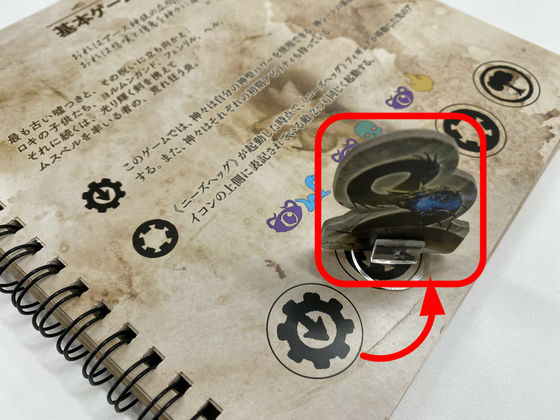
For example, in the following, Surt and Hell have reached the top world by launching Needs Heg.

And looking at the enemy wheel, both Surt and Hell already have one card. Both Sult and Hell move to move one layer directly above, but if they cannot move, they will 'cannot apply the effect of the enemy'. This is quite a pinch because the player will lose if the effect cannot be activated when the enemy starts.

In addition, if Needs Heg moves one more, it will be a victory, and one card was in play. In other words, it is a situation in which it is immediately decided whether to win or lose by drawing a card.

From the flow of play so far, I think that the card I issued is almost certainly Fenrir, 'I just activated Fenrir, I do not know what will come out because the card deck is shuffled', etc. Discuss what the enemy is. At the end of the discussion, Freya flipped over the card, saying 'I feel like it's a needs heg, but maybe it's Hell or Fenrir ...', and the needs heg was displayed wonderfully.

Needs Heg has reached the far right, and the gods have won. Play time is about 2 hours.

The Yggdrasil Chronicle looks complicated, but the basic rules are not so complicated, and it is easy for beginners to understand. The world view that the gods of Norse mythology fight against legendary monsters on a playing board in the shape of a huge Yggdrasil is a masterpiece.
Even if the situation is extremely unfavorable, it is possible to break it down by consulting between the players and sharing the role while playing. On the other hand, if you are careful, you may be able to quickly reach the point where you are defeated, and as the game progresses, the competition between the system and the player heats up. I felt the difficulty and balance of the game was exquisite.
There are many other scenarios available in the Saga Book, and it can take a huge amount of time to play them all. You can play with fresh feeling no matter how many times you play, not just playing once. Depending on the mode, there are also things that calculate and advance the experience value of the character, so it is also suitable for holding regular meetings and playing like Table Talk RPG.
However, the behavior patterns and the effects of the cards are different one by one, and it is almost impossible to remember everything. There is a lot of work to open and check the rulebook every time in the game, 'What kind of action will this enemy take when it is activated?' 'What effect did this card have?' There was a lot of time to open and watch the rulebook during play time. Since only one rulebook is recorded, when actually playing, it is recommended to prepare for the number of players by copying the 'Enemy action pattern page' and 'Card effect page' etc. Recommended.
The Yggdrasil Chronicle is available on Amazon.co.jp and can be purchased for 6229 yen including tax at the time of article creation.
Amazon | Yggdrasil Chronicle Japanese Version | Board Games | Toys

Related Posts:







